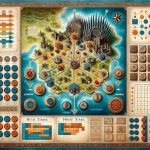The A Game of Thrones Board Game is a beloved and immersive strategy game that allows players to step into the world of Westeros and vie for control of the Iron Throne. Within the game, each player takes on the role of one of the Great Houses as they maneuver their armies and alliances in a bid for power and dominance.
House Stark, with its strong sense of honor and duty, holds a key position in the game and offers unique strategic opportunities for players.
In A Game of Thrones Board Game, House Stark is one of the noble houses competing for supremacy in Westeros. Known for their loyalty and resilience, House Stark brings a distinct set of strengths and challenges to players who choose to lead them. Understanding these dynamics is crucial for optimizing their gameplay experience.
Players must carefully consider their strategy when playing as House Stark. With its vast northern territories, formidable position on the board, and unique abilities, House Stark presents several key opportunities for players to leverage in their pursuit of victory. The right approach can make all the difference as players navigate alliances, territory control, and other essential game elements.
Overview of House Stark in the Game
House Stark is one of the most iconic and strategic houses to play in the A Game of Thrones Board Game. Known for their resilience and determination, House Stark is a force to be reckoned with in the game. As players take on the role of this noble house, they must navigate through the treacherous political landscape of Westeros, making strategic alliances and bold moves to secure their position as a dominant force in the game.
Key strategies for House Stark:
- Secure the North: House Stark’s starting position in the North makes it essential to focus on consolidating power in this region. By gaining control of essential territories such as Winterfell and Moat Cailin, players can establish a strong foundation for their expansion.
- Forge Alliances: As House Stark, it is crucial to form alliances with other players early in the game. Whether it’s joining forces against common enemies or negotiating mutually beneficial agreements, alliances can provide valuable support and protection throughout the game.
- Utilize Robb Stark’s abilities: The unique capabilities of Robb Stark, such as his ability to rally troops and lead decisive battles, should be leveraged effectively. Players should capitalize on his leadership skills to turn the tide of key conflicts and reinforce their position on the board.
Playing as House Stark requires careful planning and cunning strategy. By executing these key tactics, players can increase their chances of emerging victorious in this gripping battle for control over Westeros.
Key Strategies for House Stark
House Stark is one of the most iconic and beloved Houses in A Game of Thrones Board Game. Known for their resilient and honorable nature, players who choose House Stark must be prepared to navigate the treacherous political landscape of Westeros. In this section, we will delve into some key strategies for playing as House Stark, from initial positioning to forging alliances and utilizing the unique abilities and advantages that come with this noble House.
One crucial aspect of playing as House Stark is the initial positioning and control of territories. House Stark starts with a strong presence in the North, including Winterfell and White Harbor. It’s essential to maintain control over these territories while expanding your influence towards other parts of Westeros. Additionally, securing support from nearby Houses can help solidify your control over key areas and prevent potential invasions.
Utilizing House Stark’s unique abilities and advantages is another vital component of a successful game. The Direwolves are a powerful asset for defending territories, so strategically placing them can deter rival Houses from attacking your lands. Furthermore, leveraging Eddard Stark’s ability to muster forces can strengthen your position on the board and enhance your military capabilities. These advantages should be carefully utilized to maintain a formidable presence throughout the game.
Creating sound alliances is crucial in A Game of Thrones Board Game, especially for House Stark. Forming diplomatic relationships with other players can provide valuable support in times of need and present opportunities for coordinated attacks against common foes. However, it’s important to approach alliances with caution and always remain mindful of potential betrayals or shifting allegiances that could compromise your position in the game.
| Aspect | Description |
|---|---|
| Initial Positioning | Secure control over Northern territories such as Winterfell and White Harbor while expanding influence strategically. |
| Unique Abilities | Leverage Direwolves and Eddard Stark’s muster ability to defend territories and bolster military strength. |
| Alliances | Create diplomatic relationships with other players to gain support and coordinate attacks against common adversaries. |
Importance of Alliances in the Game
In the “A Game of Thrones Board Game,” alliances play a crucial role in the success of any house, including House Stark. Forming alliances with other players is an essential strategy for survival and domination in the game. This section will explore the significance of alliances and provide tips on how House Stark can use them to their advantage.
Strength in Numbers
One of the key reasons why alliances are important in the game is the concept of strength in numbers. As House Stark, forming alliances with other houses can provide you with additional support and resources that may be crucial for defending your territories or launching attacks against your rivals. By working together, allied houses can coordinate their movements and strategies to outmaneuver opponents and secure control over key areas on the map.
Protection and Security
Additionally, forging alliances can help House Stark enhance their security and protection. The other houses may be less likely to launch attacks against you if they know that you have strong alliances backing you up. This can give House Stark the opportunity to focus on expanding its influence without constantly worrying about potential threats from all sides. Furthermore, alliances may deter opportunistic players from targeting vulnerable territories controlled by House Stark, reducing the risk of losing valuable assets.
Political Influence
Furthermore, having strong alliances can also increase House Stark’s political influence within the game. By building rapport with other players and forming mutually beneficial partnerships, House Stark can gain leverage in negotiations and decision-making processes that could affect the outcome of conflicts and power struggles across Westeros. Leveraging these diplomatic relationships strategically can ultimately lead to greater success and dominance for House Stark in the game.
Positioning and Control of Territories
House Stark’s success in the A Game of Thrones Board Game heavily relies on their ability to strategically position and control territories. This is because House Stark’s strength lies in their defensive capabilities and controlling key areas in the game board can be crucial for their survival and expansion. The North, for example, is a pivotal starting position for House Stark as it provides them with a strong defensive stronghold while they plan their moves.
A well-thought-out strategy for House Stark involves not only holding onto their own territories but also strategically positioning themselves to block off potential threats from other houses. This can involve making alliances with neighboring houses or utilizing tactical movements to cut off enemy access to key areas of the map. By effectively controlling territories, House Stark can limit the movement and expansion of other players while securing their own position in the game.
The control of territories also allows House Stark to gather resources, strengthen their armies, and gain valuable influence over various regions. In addition, by consolidating power in specific areas, they can force opponents into difficult positions and create chokepoints that limit enemy movements. Smart use of these techniques can give House Stark a significant advantage as they navigate through the political landscape of the game of thrones”.
| Controlled Territories | Strategic Advantage |
|---|---|
| The North | Strong defense and access to resources |
| Riverrun | Strategic positioning for alliances |
| Moat Cailan | Natural defense and blocking enemy movement |
Utilizing House Stark’s Unique Abilities and Advantages
House Stark in the A Game of Thrones Board Game is known for its unique abilities and advantages that set it apart from other houses in the game. By understanding and utilizing these specific strengths, players can greatly enhance their chances of success in the game. Here are some key ways to effectively utilize House Stark’s unique abilities and advantages:
- Utilize House Stark’s strong defensive capabilities: House Stark is known for its ability to hold and defend its territories, making it crucial to focus on fortifying key areas such as Winterfell and The Twins. This defensive strategy not only protects valuable territories but also deters opponents from launching successful attacks.
- Maximize House Stark’s loyalty track: As one of the most loyal houses in the game, House Stark can benefit greatly from building alliances with other players. By maintaining a high loyalty track, players can secure support from allies when needed and strengthen their position in the game.
- Strategically use House Stark’s leaders: Characters like Eddard Stark and Robb Stark offer unique abilities that can be strategically used to gain an advantage. Whether it’s through negotiation or military prowess, leveraging the strengths of these leaders can significantly impact the outcome of the game.
Understanding how to effectively utilize these unique abilities and advantages is essential for mastering House Stark strategy in A Game of Thrones Board Game. By focusing on defensive strength, loyalty building, and strategic leadership usage, players can maximize their chances of success as House Stark and ultimately emerge victorious in the game.
Tips for Playing a Successful House Stark Game
House Stark is one of the most iconic and noble houses in the A Game of Thrones Board Game, known for its resilience, honor, and loyalty. Playing as House Stark can be both challenging and rewarding, as they are located in a strategic position on the map and have unique abilities that can be used to their advantage.
In order to play a successful House Stark game, it is important to understand their strengths and weaknesses, as well as develop effective strategies to outmaneuver opponents and secure victory.
Utilize Defensive Tactics
House Stark’s position in the north makes them vulnerable to attacks from multiple factions. As a result, it is crucial for players controlling House Stark to focus on defensive tactics. Fortifying Winterfell and other key strongholds can help fend off enemy invasions while buying time to build up forces and strengthen alliances.
Form Strong Alliances
Given their isolated location, House Stark needs to form strong alliances with neighboring houses such as Baratheon and Tully in order to survive in the game. By collaborating with other players, House Stark can ensure mutual protection against common enemies while having the opportunity to expand their influence across Westeros.
Focus on Consolidating Power
House Stark’s unique abilities are centered around consolidation of power tokens, which can be strategically used for bidding on tracks such as the influence track or mustering new units. By efficiently managing these power tokens and using them judiciously according to the current state of affairs in the game, players controlling House Stark can gain a significant advantage over their rivals.
Expert Advice From Top Players for Mastering House Stark Strategy
House Stark in the A Game of Thrones Board Game is a key player with unique advantages and challenges. Mastering the House Stark strategy requires careful planning, smart alliances, and a deep understanding of the game mechanics. Top players have shared their expert advice on how to dominate the game as House Stark.
One key piece of advice from top players is to focus on building strong alliances early in the game. House Stark’s position in the North makes them vulnerable to attacks from multiple fronts, so forming alliances with other houses can provide essential support and protection. Additionally, these alliances can help secure valuable territories and resources needed for a successful campaign.
Another vital aspect of mastering House Stark strategy is controlling and positioning your territories effectively. The North is rich in resources, but also faces constant threats from wildlings and potential invasions. Top players recommend prioritizing key territories like Winterfell and Moat Cailin while also defending against potential threats from neighboring houses.
Utilizing House Stark’s unique abilities and advantages is crucial for success in the game. From their special ability to trigger additional combat rounds to their formidable leadership under Eddard Stark, leveraging these strengths can give players a significant edge in battles and negotiations. By following these expert tips, players can elevate their House Stark game and increase their chances of victory in the A Game of Thrones Board Game.
Conclusion and Final Thoughts on House Stark’s Role in the Game
In conclusion, the House Stark strategy in A Game of Thrones Board Game is a complex and challenging one, requiring careful planning, strong alliances, and skillful control of territories. As one of the noble houses vying for the Iron Throne, House Stark brings unique abilities and advantages to the game that can be leveraged for success. By understanding key strategies, positioning, and utilizing their strengths, players can lead House Stark to victory in this epic game of strategy and conquest.
One of the key takeaways from playing as House Stark is the importance of alliances. As the northern powerhouse in the game, forming strategic partnerships with other players can provide crucial support and protection. It’s essential for Stark players to cultivate these alliances while also remaining wary of betrayal or deceit from other ambitious houses.
Furthermore, mastering House Stark strategy requires a deep understanding of positioning and control of territories. The north is vast, but also vulnerable to attacks from several directions. Successful players will need to develop a defensive mindset while also seizing opportunities to expand their influence across Westeros.
By artfully wielding House Stark’s unique abilities and advantages, such as their ability to muster troops quickly or move more freely within their own territory, players can gain an edge in this high-stakes game of political intrigue and warfare. With dedication, cunning, and a thorough grasp of these strategies, aspiring leaders can secure victory as noble champions of Winterfell.
Frequently Asked Questions
What Is the Best Strategy for Game of Thrones Board Game?
The best strategy for the Game of Thrones Board Game depends on various factors such as the house you are playing, your opponents’ strategies, and the current state of the game. It often involves a mix of diplomacy, negotiation, and tactical warfare.
Is Game of Thrones a Good Board Game?
Whether Game of Thrones is a good board game largely depends on personal preferences. It offers a complex and immersive experience with elements of strategy, diplomacy, and negotiation. Fans of the show or books may particularly enjoy it.
What Are the Playable Houses in Game of Thrones Board Game?
The playable houses in Game of Thrones Board Game are Baratheon, Stark, Lannister, Greyjoy, Martell, and Tyrell. Each house has its own unique strengths and weaknesses, as well as starting positions on the game board which can drastically affect gameplay strategies.

I love playing all kinds of games – from classics like Monopoly to modern favourites like Ticket to Ride.
I created this blog as a way to share my love of board games with others, and provide information on the latest releases and news in the industry.





